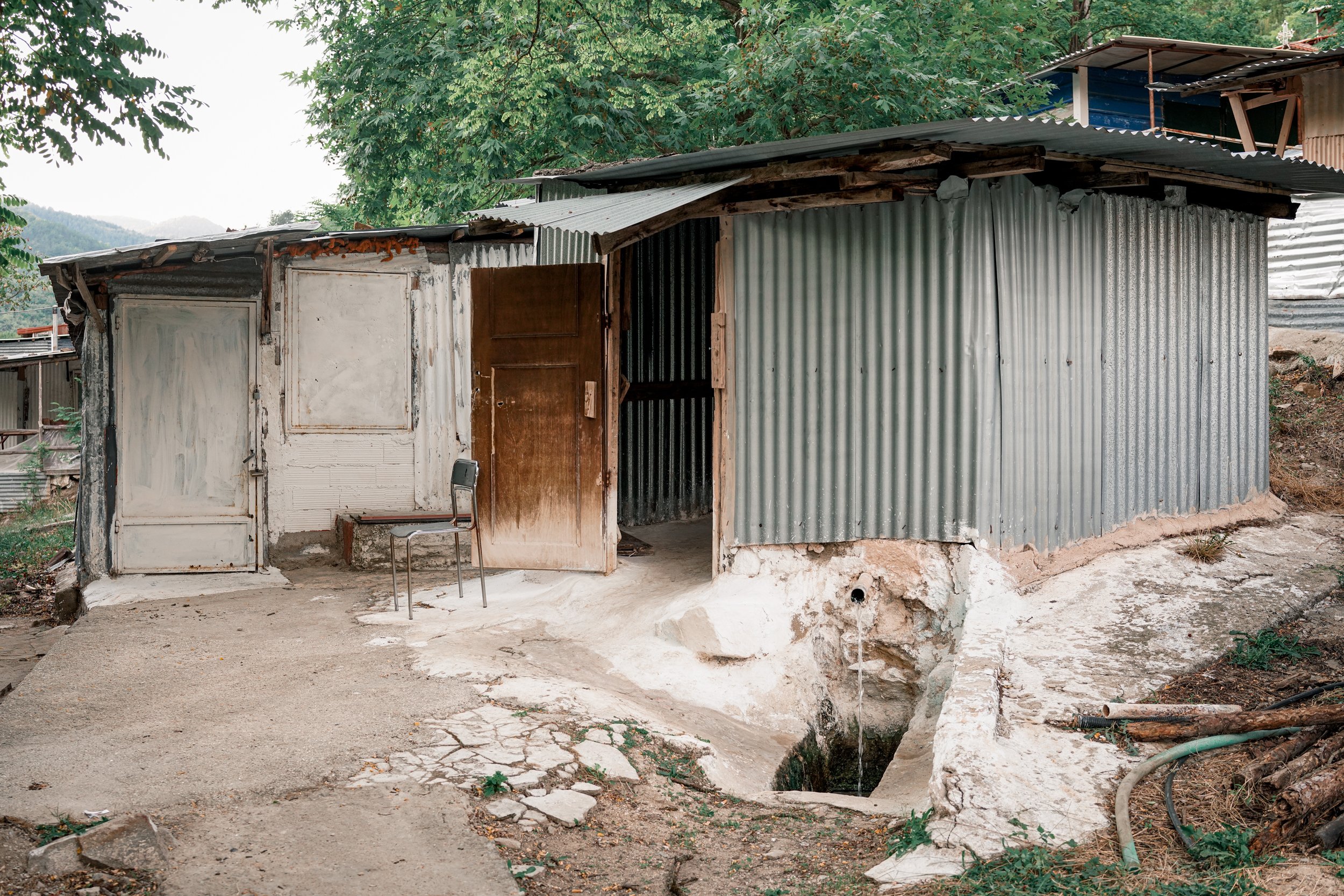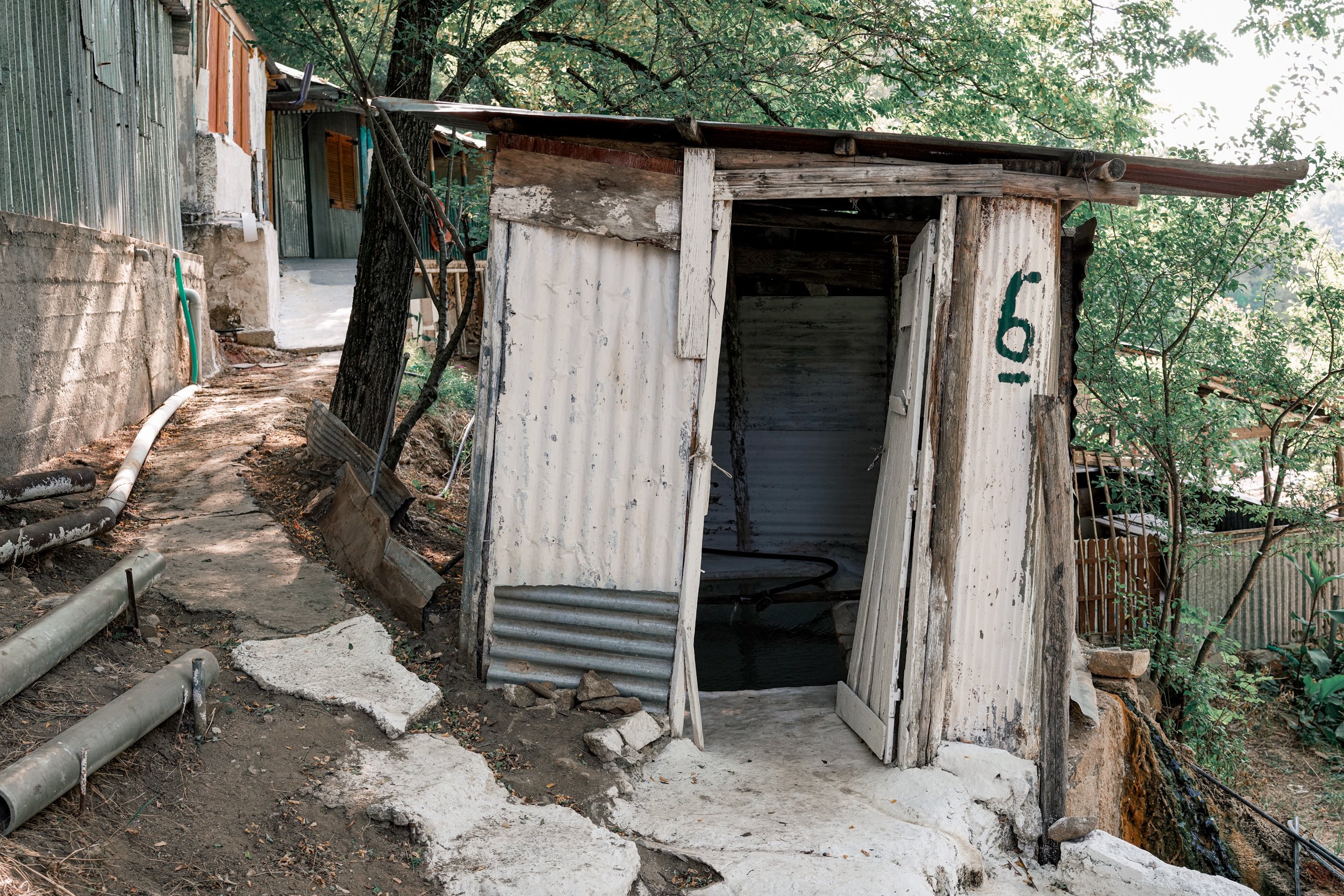The Greek Village Where Every Home Has A Hot Spring
“Hallo! Kafé?!”
A voice called down from a treehouse at the top of the village; it was the elder lady we’d approached yesterday and asked to take her portrait with her husband. We were about to go and bathe in the hot spring but we left our towels and instead wandered up to the ramshackle house with a box of lokum in hand.
We’d arrived in the village of Tarmia the previous day, a place we knew almost nothing about other than what we’d seen in a handful of roughly translated Greek news articles. What we did know was that there were hot springs here; loads of them, an entire village full, in fact.
“Where the hell are we going?” I’d wondered as I punched the coordinates of our destination into the SatNav, in the absence of any real town or road names to navigate towards. It pinpointed a tiny little white track winding through the forest of green that was the Rhodope Mountains, and it was in this direction we set course.
We pulled off the main coast road after a short while, and then we were on a winding mountain track of unknown quality for the next 90km. This track took us deeper and deeper into the mountains, leaving civilisation far behind in the rearview mirror, and I remember thinking if our van breaks down here we’re fucked.
After an hour or three of sidetracks, wrong turns, landslides and mostly paved yet overgrown road we arrived in Tarmia, marked not by a road sign but by an array of tin shacks sloping down the mountainside, an old truck bed and a big blue Mercedes bus with no windscreen that seemed to have come straight out of Into The Wild.
The village was eerily empty, with most of the hut and their adjacent thermal pools padlocked up, apart from a group of stray dogs we met inside an abandoned shack, who followed us loyally around the village for the remainder of our time there.
We spent a good couple of hours wandering through the narrow passageways between buildings, admiring the huge variety of construction materials used; most were made of corrugated tin, some of wood like log cabins; reclaimed windows and doors fit oddly into spaces, and each shack was numbered in some bizarre order that probably made sense to someone. Most of the thermal pools we could see through cracks in the doorways were carved right into the ground, big enough for two people but often drained of water. Some were decorated lavishly, some sparsely and some not at all. Our particular favourite was a pool whose walls were adorned with Versace posters brandishing perfume and beautiful women.
Many of the shacks appeared to have been abandoned some time ago, probably from the same era as the big Mercedes bus, with weeds growing through the decking and roofs collapsing in. At the bottom of the village stood a large building with pink-tiled pool rooms, smashed windows and a line of makeshift dog kennels outside.
What was this place?
Despite being in the literal middle of nowhere, the residents of the village seemed to have everything they could need. There was running hot and cold water, wood for fires and even a little Orthodox church. They had unlimited hot baths (obviously) but some of the shacks we noticed actually functioned as outhouses too, with a steady stream of thermal water to wash away the er- waste. In theory, at least.
After a good hour or so wandering around the shanty village of tin huts and wood cabins, aware only of the rule that if it was padlocked it was private, we were still no closer to finding somewhere to bathe. But we knew there were public pools here somewhere; we just didn’t know where to look.
We’d noticed an elderly man walking up the main street with his walking stick and decided to ask him.
He didn’t speak English, nor did we Greek, but we could understand a few words of German he was saying to us. He backtracked on his ramble and kindly led us to a hut of timber and tin construction containing a small yet deep pool carved out of the ground and whitewashed. It was one of the nicer huts we’d seen in the village and we felt privileged to be allowed to bathe in the product of somebody’s hard graft. The man also showed us a nearby sink with a tap that we could apparently drink from, but the water that came out was cloudy and red so we decided to give it a miss.
We thanked the man and went to grab our towels from the van, joined by a trio of dogs and a pair of inseparably affectionate cats, before locking ourselves in to what I’d dubbed the Xamam (Greek for Hammam).
Simple, rustic and incredibly hot, even the steam from the room was stifling with the door closed. The hot water was a shock against the skin, much like that of ice water, but with a little gentle easing in it felt delightful as it engulfed our bodies.
We returned at night for a candlelit soak, walking through the cold deserted village streets with only mountains, darkness and silence for company. We watched the flames flicker against the corrugated metal walls, nipping outside at regular intervals to bathe in the cool night air and pour icy spring water across our bodies.
This felt like bathing in the heart of the earth, cocooned in hot thermal waters and blissful mountain silence, alternating from hot hammam to cool starlit sky as our cares eased away.
The next morning we returned, like true addicts, to get our final fix of hot water before we departed. The night had been peaceful, so peaceful that we awoke to deafening silence during the night; not even the rush of water or a breath of wind dared make a sound.
The logging lorries thundering past at dawn did however, but that’s a minor detail.
It was en route to this final bathe that we were intercepted by the kind Greek lady who called down from the treetops and invited us in for coffee. In all honesty this was the first time we’d ever received such an invitation in Greece, although it happened on a regular basis across the Balkans and was something we’d learned to graciously accept. The coffee was a premise for a chance encounter and an opportunity to share in some local knowledge; if only we could find a common language.
The couple’s house was a large building constructed of tin and waney tree branches which blended with their surroundings, but we soon learned that it was in fact four separate units concealed inside one building, each no larger than 4m x 6m and housing one of four families, all friends.
We sat around an old desk that functioned as a table, two of us on chairs and two on a pull-out single bed. We learned their names were Vasilis and Amelia, that they spend their summers here and had been doing so for the past ten years. They were the last couple to leave the village before winter.
Amelia prepared coffee, German bread with homemade marmalade and delicious cake, while we spoke to Vasilis with the aid of Google Translate and a handful of German words.
Between 1990 and 2015 the village of Tarmia was thriving, full of families who formed one big community centred around the therapeutic benefits of hot water bathing. But recent years had seen a decline in visitors, as we’d evidenced from walking around the overgrown and dilapidated huts left open to the elements.
The spa complex down the road had been built in the early 2000’s but never opened, most likely due to the abundance of free bathing opportunities nearby, but there was now talk of developing the area for tourism, something Greece and the wider Balkan area seemed rather obsessed with- privatising natural resources for profit instead of leaving them to be enjoyed by all, young and old, rich and poor.
The shacks were used only in the summer months, much like the beach chalets we have back in England. But the interest in them was declining among younger people, and as such the village was now mainly full of elderly folk. The idea that bathing in hot springs was becoming less popular baffled us, two of the most dedicated hot spring nerds you’ll ever encounter, but it was a story not unlike others we’d heard in similar areas. The lure of the internet and modern life was too great for a generation whose iPhones were firmly cemented into their hands. You’d be as likely to find a frappé stall as a single bar of phone signal in these parts, but that was what we loved so much, the chance to be stripped away from modern life to reconnect with the wild.
There were few tourists here either, mainly day-trippers if any, and when we asked Vasilis if he’d encountered many English he replied, “Ein, zwei” and pointed at us two.
The couple themselves travelled 300km North to be here every summer and had done so for the past ten years, originally building their hut with the help of friends. The huts themselves, we learned, were non-permanent structures, as part of an agreement with the land owner from whom each person had to get approval to build. We wondered secretly if we could buy some land and live here with 24/7 access to our own personal hot spring.
We spent the most wonderful and heart-warming morning with Vasilis and Amelia, who simply would not let us leave without armfuls of cake, homemade marmalade, coffee and bagfuls of homegrown veg and walnuts. He dug out, among many oddities, some old photographs of himself from the back of his car, in which he was wearing what we’d later learn to be the traditional dress of the Sarakatsani, a nomadic group native to Northern Greece.
They waved us off as we returned for one final bathe, and left Tarmia with a newfound appreciation for Greece and Greek hospitality. Encounters like these may be small and fleeting, but they leave with us a lasting impression and fond memories of a country that cannot be taken from the pages of a guidebook.
For more about the Tarmia hot spring check out our Europe’s Best Free Natural Hot Springs guide.
As with all places, if you intend to discover this thermal spring for yourself after reading this blog, we ask that you do so with the upmost respect for the residents. We all have a responsibility to not over-popularise hidden gems like this to the point they end up as online commodities and blogger fodder. All we ask is that if you find it, don’t share the location online… Leave it to be an adventure.



































The ultimate guide to ALL of the hot springs across the Azores islands. Featuring 10 hot springs, 7 thermal spas and 4 must-see volcanic spots.